You are here: Foswiki>Gunwiki Web>RefReloading>ProcPullBulletWithHart (10 Jan 2012, SeanNewton)Edit Attach
Pulling Bullets with an RW Hart Bullet Puller
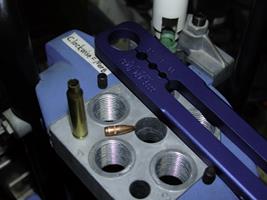 The RW Hart bullet puller is a "pliers style" bullet puller. While you can order it directly from RW Hart, most folks tend to buy or hear about these tools via MidwayUSA. Unfortunately, there don't seem to be a lot of instructions on it, and a recent Google search showed that a lot of folks don't know how they work (or how well they work). To be fair, when I first bought it, I tried it - it didn't work well for me at all (entirely due to my not knowing how to use it), so I set it aside and forgot about it for a few years. In the meantime, I used a hammer-style kinetic bullet puller when I needed to.
The RW Hart bullet puller is a "pliers style" bullet puller. While you can order it directly from RW Hart, most folks tend to buy or hear about these tools via MidwayUSA. Unfortunately, there don't seem to be a lot of instructions on it, and a recent Google search showed that a lot of folks don't know how they work (or how well they work). To be fair, when I first bought it, I tried it - it didn't work well for me at all (entirely due to my not knowing how to use it), so I set it aside and forgot about it for a few years. In the meantime, I used a hammer-style kinetic bullet puller when I needed to.
Three years later, I had some 223 bullets to pull and I came across this in my parts bin. I've learned a lot since then, and this time using it seemed fairly intuitive. What follows is how I use it - I'm not sure if it's the "right" way, but this works for me.
An Overview of my Setup
My reloading press is a Dillon 650. While it works for me, any press with a flat top should work just as well. I doubt that slender single-stage presses would work well with this, but most progressives or turret presses should have enough level space on top to do it. Some larger single stages (RCBS's, for instance) probably have enough level space on top too. My Hart puller has holes for 22cal / 6mm / and 30cal..Impressions of the Hart Tool
Now that I know how to use it, the Hart tool has become my preferred bullet puller for 223 Rem / 5.56mm. It's considerably faster to use than a hammer-style kinetic puller. Damage to the bullets seems limited to scuffs and (depending on how much force is applied) a little bit of deformation on the bullets. I wouldn't count on these bullets for precision work afterwards, but they'll be fine for plinking.Using it, Illustrated
As always in Gunwiki articles, feel free to click the images for a higher resolution view. A bullet in position to be pulled. Note that for 223 Remington, the base of the bullet is perfectly even with the top of the toolhead. If any of the brass case were sticking through, it would be necessary to put some spacers in place under the Hart tool so that you won't catch the neck of the cartridge instead of the bullet. I'd suggest appropriately sized blocks of cardboard or wood, personally. If you didn't want to bother with spacers, you could also just be careful how far up you send the ram of your press.
A bullet in position to be pulled. Note that for 223 Remington, the base of the bullet is perfectly even with the top of the toolhead. If any of the brass case were sticking through, it would be necessary to put some spacers in place under the Hart tool so that you won't catch the neck of the cartridge instead of the bullet. I'd suggest appropriately sized blocks of cardboard or wood, personally. If you didn't want to bother with spacers, you could also just be careful how far up you send the ram of your press.
 The puller in position over the bullet. Note that the body of the bullet meets up with the bottom of the Hart puller. What's important about the top of the press is that it's a perfectly flat surface, and the bullet can't shift to either side. When I was trying to pull bullets before (and having miserable luck with it), I didn't have the Hart tool level like this.
The puller in position over the bullet. Note that the body of the bullet meets up with the bottom of the Hart puller. What's important about the top of the press is that it's a perfectly flat surface, and the bullet can't shift to either side. When I was trying to pull bullets before (and having miserable luck with it), I didn't have the Hart tool level like this.
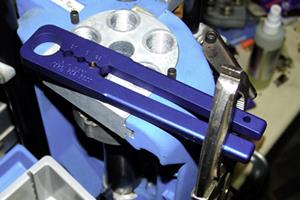 I used a pair of vise-grip pliers to place consistent tension on the handle of the Hart tool. If you're worried about scratching the finish, you can line the jaws of the pliers with electrician's tape. Before I thought of this technique, one reason I had poor results with this tool years ago was that I couldn't maintain consistent enough pressure on the Hart tool with my bare hands.
I used a pair of vise-grip pliers to place consistent tension on the handle of the Hart tool. If you're worried about scratching the finish, you can line the jaws of the pliers with electrician's tape. Before I thought of this technique, one reason I had poor results with this tool years ago was that I couldn't maintain consistent enough pressure on the Hart tool with my bare hands.
 Another view of the pliers locked in on the Hart tool.
Another view of the pliers locked in on the Hart tool.
 A side view. Note that the bottom of the case is locked into the shellplate.
A side view. Note that the bottom of the case is locked into the shellplate.
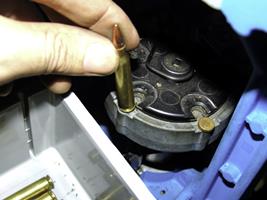 Putting the next bullet into the shellplate. As you can tell from the gunpowder (IMR4198, a rod powder - it looks like gray donut sprinkles) , most of these cases are being pulled because they're missing a primer.
Putting the next bullet into the shellplate. As you can tell from the gunpowder (IMR4198, a rod powder - it looks like gray donut sprinkles) , most of these cases are being pulled because they're missing a primer.
 The round is now in position, ready for me to pull the lever and raise the shellplate up to the toolhead.
The round is now in position, ready for me to pull the lever and raise the shellplate up to the toolhead.
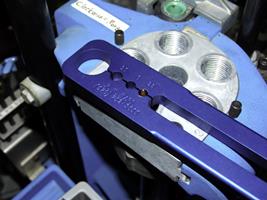 Here, I've placed the Hart bullet puller over the bullet. At this point, the pliers haven't been attached so there's a relatively gap visible between the two sides of the tool.
Here, I've placed the Hart bullet puller over the bullet. At this point, the pliers haven't been attached so there's a relatively gap visible between the two sides of the tool.
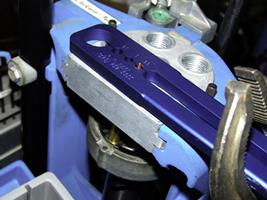 Tension has been applied to the pliers - the gap is considerably smaller in this picture than in the previous. It's now ready for me to return the lever on the press, which will pull the shellplate (which the brass is secured to) down and pull it free of the bullet (which is trapped in the Hart tool).
Tension has been applied to the pliers - the gap is considerably smaller in this picture than in the previous. It's now ready for me to return the lever on the press, which will pull the shellplate (which the brass is secured to) down and pull it free of the bullet (which is trapped in the Hart tool).
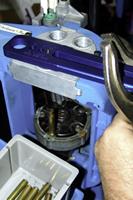 Success - the bullet has been held in place by the tension of the Hart tool, and the case has been pulled off. This bullet has been pulled, and exhibits minimal deformation.
Success - the bullet has been held in place by the tension of the Hart tool, and the case has been pulled off. This bullet has been pulled, and exhibits minimal deformation.
Please note that the Hart tool occasionally needs a few tries before it can grab the bullet, particularly if it's seated too low. -- SeanNewton - 10 Jan 2012
Edit | Attach | Print version | History: r1 | Backlinks | View wiki text | Edit wiki text | More topic actions
Topic revision: r1 - 10 Jan 2012, SeanNewton
%META:TOPICINFO{author="ProjectContributor" date="1231502400" format="1.1" version="1"}%
 Copyright © by the contributing authors. All material on this collaboration platform is the property of the contributing authors.
Copyright © by the contributing authors. All material on this collaboration platform is the property of the contributing authors. Ideas, requests, problems regarding Foswiki? Send feedback
